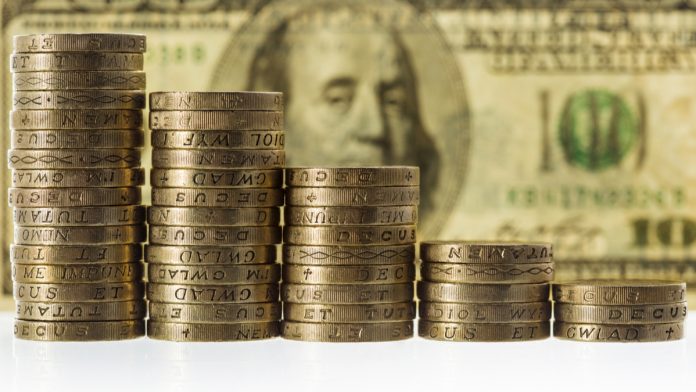The pound advanced versus the US dollar for a third straight session on Thursday. Closing up 0.6% at US$1.2367, the pound is on track to gain over 1.3% across the week so far. The pair was seen slipping lower in early trade on Friday.
| What do these figures mean? |
| When measuring the value of a pair of currencies, one set equals 1 unit and the other shows the current equivalent. As the market moves, the amount will vary from minute to minute.
For example, it could be written: 1 GBP = 1.28934 USD Here, £1 is equivalent to approximately $1.29. This specifically measures the pound’s worth against the dollar. If the US dollar amount increases in this pairing, it’s positive for the pound. Or, if you were looking at it the other way around: 1 USD = 0.77786 GBP In this example, $1 is equivalent to approximately £0.78. This measures the US dollar’s worth versus the British pound. If the sterling number gets larger, it’s good news for the dollar. |
With Prime Minister Boris Johnson’s Brexit strategy in tatters, Parliament denying the PM a general election and even Boris Johnson’s brother quitting, the pound continued to advance in the previous session.
The pound is set for its biggest weekly increase since May after Parliament forced Boris Johnson to postpone Brexit for three months until 31st January. The possibility of a general election still exists. Political analysts expect Boris Johnson to try to secure the votes needed for a general election again on Monday. However, the opposition appear keen to see a law against a no deal Brexit in place before any general election is agreed to.
Analysts consider the most likely course of events now will be a Brexit delay until 31st January and an election that will be held after the initial October deadline but before the January deadline. A delay of both Brexit and an election is sent the pound higher. This is because political risk and a no deal Brexit are both being pushed back.
| Why is a “soft” Brexit better for sterling than a “hard” Brexit? |
| A soft Brexit implies anything less than UK’s complete withdrawal from the EU. For example, it could mean the UK retains some form of membership to the European Union single market in exchange for some free movement of people, i.e. immigration. This is considered more positive than a “hard” Brexit, which is a full severance from the EU. The reason “soft” is considered more pound-friendly is because the economic impact would be lower. If there is less negative impact on the economy, foreign investors will continue to invest in the UK. As investment requires local currency, this increased demand for the pound then boosts its value. |
Today developments in Westminster will remain in focus.
US Jobs Report To Boost Dollar?
The dollar traded broadly flat in the previous session following a mixed batch of data. Whilst initial jobless claims disappointed, the ISM non- manufacturing figures beat analysts’ expectations. The US service sector jumped to 56.4, well ahead of the 54 analysts forecast. This is also solid increase from July’s 53.7.
The strong data dampened fears that the slump in the US manufacturing sector owing to the US — Sino trade dispute, was spilling over into the service sector. The fact that the service sector remains strong is particularly important because the service sector is by far the dominant sector in the US economy.
Today attention will be firmly on the US non-farm payroll report. This is the most closely watched report of the month. Analysts are expecting 160,000 jobs to have been created in August, in line with July. Unemployment is expected to have held steady at a half century low. City analysts forecast that wage growth will have cooled. The private sector ADP report was better than expected. Economists consider this to be an indication that the Labour department’s job report could also surprise to the upside.
| How does the non-farm payroll (NFP) affect the US dollar? |
| It works like this, when there is low unemployment and high job creation, the demand for workers increases. As demand for workers goes up, wages for those workers also go up. Which means the workers are now taking home more money to spend on cars, houses or in the shops. As a result, demand for goods and services also increase, pushing the prices of the goods and services higher. That’s also known as inflation. When inflation moves higher, central banks are more likely to raise interest rates, which then pushes up the currency’s worth. |
Currencylive.com is a site operated by TransferWise Inc. (“We”, “Us”), a Delaware Corporation.
The content on our site is provided for general information only. It is not intended to amount to advice on which you should rely. You must obtain professional or specialist advice before taking, or retain from, any action on the basis of the content on our site.
Although we make reasonable efforts to update the information on our site, we make no representations, warranties or guarantees, whether express or implied, that the content on our site is accurate, complete or up to date. Some of the content posted on this site has been commissioned by Us, but is the work of independent contractors. These contractors are not employees, workers, agents or partners of TransferWise and they do not hold themselves out as one. The information and content posted by these independent contractors have not been verified or approved by Us. The views expressed by these independent contractors on currencylive.com do not represent our views.





